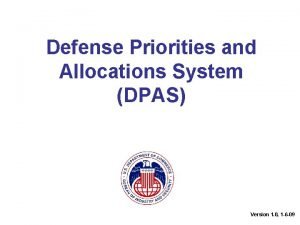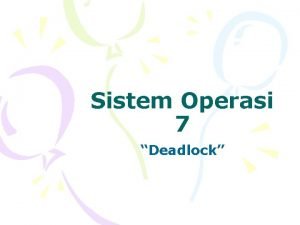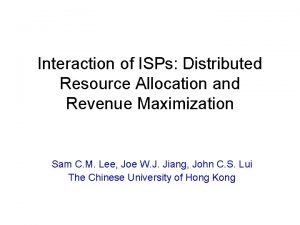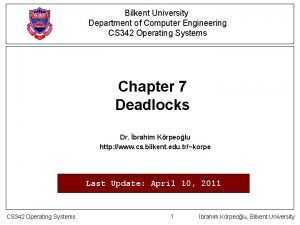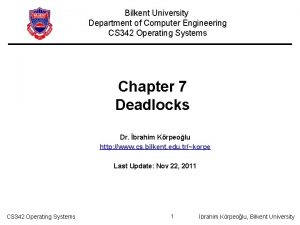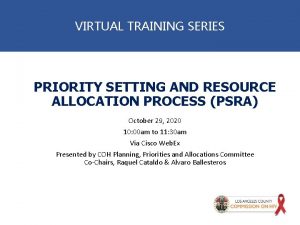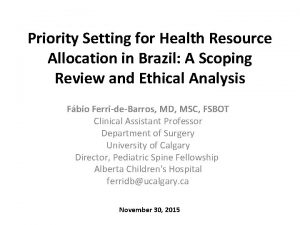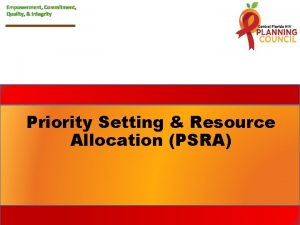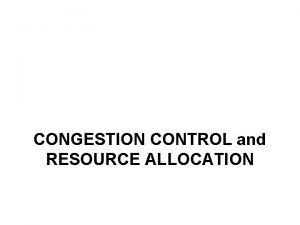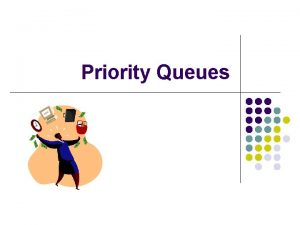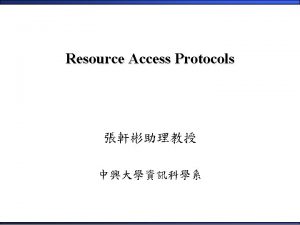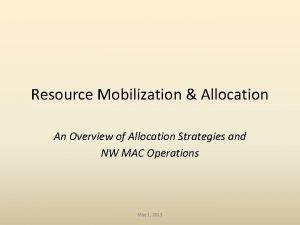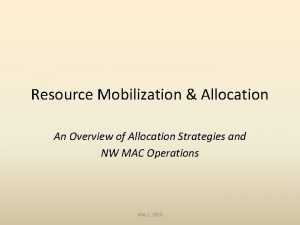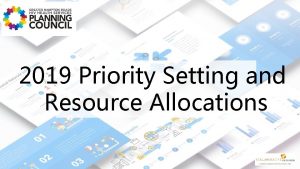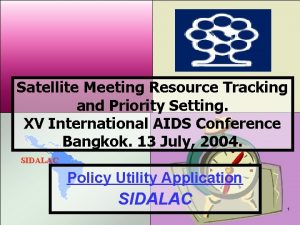Priority Setting and Resource Allocation Slides for Module




































![Allocation and Use of Part A Funds [Without a Waiver] Allocation of Program Funds Allocation and Use of Part A Funds [Without a Waiver] Allocation of Program Funds](https://slidetodoc.com/presentation_image_h2/2025020396ee93b6f54c9093f27abe54/image-37.jpg)








































- Slides: 77

Priority Setting and Resource Allocation Slides for Module 5

Training Objectives Following the training, participants will be able to: PSRA Importance and Context: 1. Explain the 4 components of PSRA as specified in the RWHAP legislation 2. Identify at least 5 HRSA/HAB expectations for the PSRA process Priority Setting, Resource Allocation, and Directives: 3. Describe suggested steps in priority setting 4. Describe suggested steps in resource allocation 5. Identify the 3 main types of directives

Training Objectives (cont. ) Implementing PSRA: 6. Describe the 2 most common approaches used by EMAs and TGAs for PSRA 7. Describe how PC/PBs can manage conflict of interest (COI) in PSRA 8. Explain the role of the recipient in PSRA Reallocation: 9. Explain the importance of reallocation 10. List 5 steps in managing the reallocation process

PSRA Importance and Context

Legislative Language on PSRA DUTIES The planning council shall: “establish priorities for the allocation of funds within the eligible area, including how best to meet each such priority and additional factors that a grantee should consider in allocating funds under a grant” § 2602(b)(4)(C)

PSRA: A PC/PB Responsibility • Planning council is the decision maker about the use of RWHAP Part A program funds – at least 85% of the total grant award – Recipient must manage procurement so that funds are spent on services in the amounts determined by the PC – Funds can be moved among service categories only with PC approval • Planning body sets priorities and recommends allocations and directives to the recipient

HRSA/HAB Expectations for PSRA • There are many “right ways” to carry out PSRA • Process should be: – – – Appropriate for your EMA or TGA Carefully considered and discussed Based on agreed-upon principles and criteria Documented in writing Followed consistently Reviewed annually and updated as needed

HRSA/HAB Expectations for PSRA (cont. ) • The entire PC/PB participates actively in decisions about priority setting and resource allocation • Decisions are made based on data, not anecdotal information or “impassioned pleas” – PC reviews many types of data and directly links decision making to these data • Meetings are open, but practices regarding public comment vary, and only vetted PC/PB members vote • Conflict of interest is managed • Both the actual process and results of PRSA are documented in writing

Examples of Principles for PSRA Decisions will: 1. Contribute to parity in access to care for all PLWH regardless of where they live in the EMA/TGA 2. Consider the needs of specific populations, including disproportionately affected and traditionally underserved groups 3. Help to reduce unmet need among PLWH who know their status but are not in care 4. Contribute to an improvement in HIV care continuum performance for all RWHAP clients 5. Be data-based, with greater weight given to data that have larger samples and are more representative

Quick Scenario A: Principles to Guide PSRA Assume that your PC/PB is discussing principles to guide its PSRA process. The PSRA Committee has recommended the five principles shown on the previous slide. Several PC/PB members object to Principles #2 and #3. As the PSRA Chair, you are asked to respond. 1. How would you explain/defend Principle #2? 2. How would you explain/defend Principle #3? 3. Why is it important for the entire PC/PB to discuss and agree on these principles to guide PSRA?

Why is PSRA so important? • PSRA decisions greatly influence the system of care, including: – What services are available to PLWH in the EMA or TGA – Accessibility of those services – where services are provided – Capacity of funded providers to meet the needs of specific PLWH subpopulations – and address HIV-related health disparities – Service models used – Service retention – Clinical outcomes like viral suppression

PSRA: The PC/PB’s Most Important Role

Components of PSRA 1. 2. 3. 4. Priority setting Resource allocation Reallocation (as needed during the program year) Development of directives – “how best to meet each priority” …all based on needs assessment and recipient data, obtained analyzed throughout the year

Quick Scenario B: Priority Setting Your PC/PB is holding its priority setting meeting, and has begun to review current service priorities. A new member, appointed just a month ago, asks why the AIDS Drug Assistance Program (ADAP) is rated near the top when “It didn’t receive any Part A funds this year or last year and the state seems to have plenty of money to fund it. ” Shouldn’t we prioritize only the services that need Part A funds? Is this a good idea? Why or why not?

Priority Setting The process of deciding which HIV/AIDS services are the most important in providing a comprehensive system of care for all PLWH in the EMA/TGA.

HRSA/HAB Expectations for Priority Setting • Priorities are developed based on service needs of all PLWH in the EMA or TGA, regardless of: – Who they are – Where they live • PC/PB must establish a sound, fair process for priority setting and ensure that decisions are data based • Services prioritized must be from those listed in the legislation and described by HRSA/HAB as fundable through RWHAP Part A

HRSA/HAB Expectations for Priority Setting (cont. ) • Priority is based on the importance of services to diverse PLWH living in the EMA or TGA – which services should be a part of the comprehensive system of quality care • Decisions on priorities should not consider sources or amounts of funding for these services – Even if the PC/PB cannot fund all prioritized services, additional resources could become available – or other funding for an important service might be lost – A PC/PB should never allocate funds to a service category that is not prioritized

Sound Practices in Priority Setting • Set priorities after the annual Data Presentation • Prioritize each of the 28 service categories that is important to PLWH in your EMA/TGA – exclude only services that are not needed • Begin with current year’s priorities and revise from there – some EMAs/TGAs do a full “reprioritization” every 3 -4 years and a review and updating in between

Priority Setting: Steps 1 -3 1. Agree on the principles, criteria, and decisionmaking process for priority setting 2. Review and clarify current HRSA/HAB service category definitions* and any EMA/TGA-specific refinements for: – Core medical-related services – Support services 3. Review information inputs from year-round work and from your data presentation * Found in HRSA/HAB Policy Clarification Notice (PCN) #16 -02

Priority Setting: Step 4 4. Review and discuss: – Current priorities and rationale – Implications of needs assessment, service utilization, and other data “inputs” – to identify possible need to revise priorities – Which service categories appear to need higher or lower priority based on the needs of all PLWH or particular subpopulations

Priority Setting: Steps 5 -8 5. Use the approved process for decision making – Electronic or paper prioritization sheets – Some other form of voting – Consensus based on discussion 6. Review priorities following any numerical process to be sure they reflect agreed-upon principles and criteria 7. Take a final vote on the entire list of service priorities 8. If entire PC/PB did not participate, present recommendations and rationale to the full PC/PB

Directives are the PC/PB’s guidance to the recipient on “how best to meet each such priority and additional factors” to consider in procurement.

Develop Directives Before Resource Allocation Directives can be developed year-round but are best completed and adopted prior to resource allocation because they often have fiscal implications: • The cost of implementing a directive needs to be included in the allocation for the affected service category • Adding funds to one category may require reducing funds for other categories – best done as part of the allocation process

Directives: Purposes and Examples 1 1. Ensuring availability of services in all parts of the EMA/TGA or in a particular county or area Examples: – PLWH located in all three regions of the EMA/TGA must be able to obtain outpatient ambulatory health services (HIVrelated medical care) within their region or less than 5 miles outside it – Mental health services must be available in Outlying County A

Directives: Purposes and Examples 2 2. Ensuring services appropriate for specific target populations Examples: – Core medical service providers must have bilingual Spanish -English staff in positions with direct client contact, including clinical staff – Each of the three counties in the EMA/TGA must have at least one service provider qualified to provide culturally appropriate services to young MSM of color

Directives: Purposes and Examples 3 3. Overcoming barriers that reduce access to care Examples: – Every funded outpatient ambulatory health services (OAHS) provider and medical case management provider must offer services at least one evening each week or one weekend day each month – Transportation must be made available to PLWH who are unwilling to obtain care in their own communities due to fear of exposure and stigma, and who require such assistance so they can access care in another location within the EMA or TGA

Directives: Purposes and Examples 4 4. Calling for the testing or broader use of a particular service model Examples: – At least one medical provider will receive funds to test a Rapid Response linkage to care model, designed to ensure that newly diagnosed PLWH clients have their first medical visit within 72 hours after receiving a positive test result – All medical case management providers will ensure that at least one case manager completes recipient-approved geriatric training on a refined case management model for older PLWH

HRSA/HAB Expectations – Directives Should: • Address a documented need, often using data/analyses based on information from: – Needs assessment – service gaps or problems identified by consumers or providers – HIV care continuum – disparities in linkage to care, retention, and/or viral suppression among specific PLWH populations – Service utilization – disparities in use of particular service categories by different PLWH populations – Clinical Quality Management – changes in service models that improve patient care, health outcomes, and patient satisfaction

HRSA/HAB Expectations (cont. ) – Directives Should: • Be explored and developed as needed throughout the year – often with the involvement of several committees, such as the following: – – Needs Assessment and Planning Care Strategy/System of Care Consumer/Community Access Priority Setting and Resource Allocation • Be presented in relation to the PSRA process, since they often have financial & procurement implications • Be approved by the full PC/PB, along with or separate from resource allocations

HRSA/HAB Expectations – Directives Must Not: • Have the effect of limiting open procurement by making only 1 -2 providers eligible Examples: – OK: Mental health services must be provided by clinicians that can demonstrate expertise in serving people living with HIV – Not OK: Mental health services must be provided by organizations with prior RWHAP experience

Quick Scenario C: Directives The PC/PB is concerned about the low retention in care formerly incarcerated PLWH, who also have high rates of substance use. The Care Strategy Committee has been exploring ways to address this problem and has suggested testing either a peer navigator model associated with medical care management or an intensive case management model with specially trained case managers. 1. How might a directive be used in this situation? 2. What might the directive say?

In Developing Directives, PC/PBs should: • Work with the recipient to explore cost implications Example: To improve retention of employed PLWH, the PC/PB wants to require OAHS and medical case management providers to have evening or weekend hours – Cost implications: Adding evening or weekend hours adds costs for staff and for keeping the facility open longer – Funding implications: Implementing this directive will require adding funds to OAHS and medical case management or serving fewer people in these service categories

After a Directive is Approved • Recipient must follow directives in procurement and contracting but cannot always guarantee full success Example: – Recipient puts out a request for proposals but receives no qualified responses • Recipient should be asked to provide updates on implementation of directives • PC/PB and recipient should work together to assess the results and value of the directive

Resource Allocation The process of deciding how much RWHAP Part A funding to provide for each prioritized service priority

HRSA/HAB Expectations for Resource Allocation • Funds may be allocated only to prioritized service categories that are legislatively approved for funding • Recipient provides data and advice, but the PC is the decision maker • Must use a fair, data-based process that manages conflict of interest • Process must be documented in writing and followed consistently – otherwise affected parties may file a grievance against the PC/PB

HRSA/HAB Expectations for Resource Allocation (cont. ) • A committee may do the initial work, but: – The entire PC/PB should participate in the data presentation – Allocation recommendations from a committee must be reviewed, actively discussed, and approved by the entire PC/PB • Only vetted PC/PB members may vote on allocations • At least 75% of program funds must be allocated to core medical-related services, unless the EMA/TGA obtains a waiver from HRSA/HAB
![Allocation and Use of Part A Funds Without a Waiver Allocation of Program Funds Allocation and Use of Part A Funds [Without a Waiver] Allocation of Program Funds](https://slidetodoc.com/presentation_image_h2/2025020396ee93b6f54c9093f27abe54/image-37.jpg)
Allocation and Use of Part A Funds [Without a Waiver] Allocation of Program Funds [CATEGOR Y NAME], [VALUE] [CATEGORY NAME], [VALUE]

Core Medical-Related Services • ADAP • Local Pharm Assistance Program • Early Intervention Services • Health Insur Premium and • Cost-Sharing Assistance • Home & Community-based Health Services • Home Health Care • Hospice Medical Case Management Med Nutrition Therapy Mental Health Services Oral Health Care Outpat/Ambulatory Health Services • Substance Abuse Outpatient Care • • •

Support Services • Child Care Services • Emergency Financial Assistance • Food Bank/Home-Deliv Meals • Health Educ/Risk Reduction • Housing • Linguistic Services • Medical Transportation • Non-Med Case Management • Other Professional Services • Outreach Services • Psychosocial Support Services • Referral for Healthcare & • Support Services • Rehabilitation Services • Respite Care • Substance Abuse Servs (Resid)

Approaching Resource Allocation • Sound practice is to use 3 funding scenarios in order to adjust allocations easily once funding is received, usually: – flat funding – 5%+ increase – 5%+ decrease • Separate allocation process needed for Part A and Part A Minority AIDS Initiative (MAI) funds • Allocations should consider costs per client – which means doing allocations in dollars, not just percent of funds

Approaching Resource Allocation (cont. 1) • Process must be data based, and should consider: – Number and characteristics of clients in each service category last year and demand in current year – PLWH needs assessment data on service needs and gaps – Cost per client for each service category – Funds provided through other funding streams – Plans for bringing additional PLWH into care

Approaching Resource Allocation (cont. 2) • Some highly ranked service categories may receive little or no funding because: – Needed funds are provided by other funding sources – for example, RWHAP Part B may meet need for HIV-related medications through ADAP – Some services are needed by a small subset of PLWH – for example, linguistic services – Some services involve relatively low costs – for example, child care • Allocations are included in the annual application for RWHAP Part A funding

Quick Scenario D: Resource Allocation Your PC/PB is trying to decide whether additional funding is needed for Medical Transportation. It was not identified as a key concern by 35 people attending 2 town hall meetings prior to PSRA, but was among the top 7 service gaps identified in the most recent survey of 620 PLWH. • To which of these data sources should the PC/PB give more “weight, ” and why? • What other data should it review in making this allocation decision?

Steps in Resource Allocation 1 and 2 1. Obtain agreement from the full PC/PB on principles, criteria, and decision making process/methods for allocating funds 2. Review financial and utilization data, including: – Final allocations for the current program year – Final expenditures vs. allocations for each funded service category in the prior program year – Number of clients served last year and costs per client or unit for each service category – Decide whether to use last year’s final allocations or current year allocations as a starting point

Steps in Resource Allocation 3 and 4 3. Review and approve directives, so that their costs can be considered in the allocation process 4. Make allocations by service category, based on projected number of clients and costs per client – Project on a screen both current and proposed allocations for each service category for review during the process – Keep separate track of total allocations for core medical-related services and support services allocations – Vote on allocations for each service category or group of categories – Consider cost of proposed directives

Steps in Resource Allocation 5 -8 5. Review and vote on the total allocation for “flat” funding 6. Repeat Step 5 for increase and decrease scenarios 7. Repeat for MAI 8. Document the discussion and decisions, including reasons for any changes in funding and for amounts allocated

Steps in Resource Allocation 9 and 10 9. Schedule a review of the process within a month after implementation to: – Identify any data gaps or process issues that need improvement for next year – Assign responsibility for changes to specific committees – Work with the recipient on data or other issues – Be sure process changes are presented and approved before next year’s PSRA process begins 10. Be prepared to revise allocations once the award is received from HRSA/HAB

Models for Implementing PSRA • Factors to Consider • Committee-based Models • Full PC/PB-based Models

Managing Conflict of Interest in PSRA • Process must manage conflict of interest (COI) • A provider member that receives or is seeking funds under RWHAP Part A should have limited participation in discussion and should not vote on motions involving service categories where there is a COI – Exception: generally OK to vote on the full slate of services • Subrecipients can provide input to the process during town halls or a provider forum • Sound practice is not to allow a subrecipient to initiate discussion during PSRA decision making sessions • Content questions about a service category should go to staff rather than funded providers

Managing Anecdotes & Impassioned Pleas • PLWH, providers, and other community members should have an opportunity to present their perspectives prior to PSRA • New information should not be presented during decisionmaking meetings when there is no way to check it • Training on using data for decision making should help PC/PB members understand when to serve as advocates and when to act as planners on behalf of all PLWH in the jurisdiction – PSRA requires planners who make decisions based on the best available data

Roles of the Recipient in PSRA • Provides considerable data for PSRA • Often asked to provide and present suggestions or factors to consider in making allocations • Provides pre-meeting input on the costs of implementing proposed directives • Has several staff present throughout the process to provide data and answer questions • Serves as a source of information about the system of care – so these questions are not addressed by subrecipients with conflicts of interest • Does not vote or try to influence decision making

Options Available to EMAs/TGAs PC/PB should consider various factors in choosing a PSRA model: • Whether initial work and recommendations will be done in committee or by the entire PC/PB • Whether the process will occur through meetings over several months or in several days of intensive sessions • How to provide and manage data – presentations over multiple PC/PB meetings with summaries just before PSRA or a major data presentation to begin PSRA • What aids to use –spreadsheets, scorecards, data matrix summaries– to maximize data-based decision making • How to develop and adopt directives

Committee-based Model • Work often involves several committees – Needs Assessment: Manage data presentation – Care Strategy/System of Care: Develop directives – PSRA: Develop recommendations to full PC/PB • All PC/PB members attend the data presentation

Committee-based Model: PSRA Committee • The PSRA Committee: – Should be as diverse as possible, representative of the populations in the jurisdiction’s HIV/AIDS epidemiology – Must not be provider-driven due to COI issues – with providers not voting on most decisions, decisions might be made by very few PC/PB members – Should focus on use of most recent available data – Develops recommendations with a clear rationale

Committee-based Model: Executive Committee • Recommendations go first to the Executive Committee and then to the full PC/PB, including: The principles, criteria, and process used Key data inputs An overview of recommended allocations Recommended changes in allocations by service category including specific data-based reasons for those changes – Information on cost implications of directives – – • Executive Committee: – Identifies any data (from the data presentation) that may not have been fully considered – May ask for revisions in recommendations or in the written rationale for them

Committee-based Model: Full PC/PB • Full PC/PB receives, reviews, discusses, and either modifies or approves committee recommendations • The PC/PB should: – Schedule an in-depth presentation and review of recommendations – Review data and ask questions – Make needed revisions or send recommendations back to committee for further work – Approve recommendations based on data-based, informed review

Full PC/PB Model • Same components, but involves entire PC/PB • Only members who participate in the data presentation may vote on PSRA • Data presentation, priority setting, and resource allocations often scheduled on separate days • Voting often used rather than consensus due to group size • Directives often developed ahead, but presented for approval just before resource allocations • Process needs careful scheduling and strong meeting management by a Co-Chair or outside facilitator • Process should be reviewed just before process begins

Quick Scenario E: PSRA Models Discuss the following: • Does your EMA/TGA use a committee-based or full PC/PB PSRA process? Why was it chosen? • What are some advantages of a committee-based approach? Disadvantages? What actions can help make it fair and effective? • What are some advantages of a full PC/PB model? Disadvantages? What actions can help make it manageable and effective?

Reallocation Moving funds from a prioritized service category following initial allocation, to reflect actual funding received and ensure that all funds are expended on needed services

Timing of Reallocation 1. After a partial or final grant award is received, since total or final amount received is usually higher or lower than the amount requested – Reallocation can be calculated based on percent of funding provided to each service category in the allocation scenario, then approved by the PC/PB – PC/PB may choose to refine allocations based on award amount 2. During the program year, when some service categories are underspent and others have greater demand

RWHAP Legislation Provides Penalties for “Unobligated” Funds • If an EMA or TGA has more than 5% of its formula award unspent at the end of the program year: – Amount over 5% is deducted from the amount awarded the following fiscal year – EMA/TGA cannot compete for supplemental funds in the next application cycle – it receives only formula funds • Means if funds left unobligated in FY 2019, no supplemental funding and a deduction from formula funds in FY 2021 – Jurisdiction can request use of funds as “carryover” for the following year but approval is not assured

Reallocation Prevents “Unobligated” Funds • Many factors can contribute to underspending: – Reduced demand for services – Long-term staff vacancies – Natural disasters or sustained bad weather that prevents clients from accessing services – Damage to facilities that prevent or reduce ability to provide services – Management issues • *Timely reallocation moves funds that could otherwise go unused – so they are spent on needed services

Two Types of Reallocation 1. Moving funds from underspent providers to those in the same service category who are spending at a higher level [Decision is made by the recipient] 2. Moving funds from underspent service categories to different service categories that: – – Are spending at a higher level Need additional funds to meet the need for services [PC must approve; PB can recommend]

HRSA/HAB Expectations for Reallocation • PC must approve reallocation of funds across service categories as part of its legislative responsibility for the “allocation of funds”; PB should recommend reallocation using a similar process • Reallocation should happen as soon as it is clear that funds will not be fully spent – Recipient must revise subrecipient contracts to move funds – Subrecipient needs time to spend additional funds • PC should have a reallocation process, including a special “rapid reallocation” process for use late in the program year

Managing Reallocation 1 1. Develop a reallocation policy and process – Specifies how PC will determine reallocations – Indicates what if any percent or maximum amount of funds can be moved by recipient without prior PC approval • For example: No prior PC approval required for reallocation across service categories of amounts up to 5% of the total allocation for that service category or $150, 000, whichever is less – Includes a “rapid reallocation process for use in the last 3 -4 months of the program year (Nov-Feb)

Managing Reallocation 2 2. Think about reallocation priorities during PSRA: – When making allocations, consider where the PC/PB would like to be able to put additional funds if available – consider developing a “reallocation priorities list” to use if funds become available – In refining allocations as necessary after the final award is received, review/refine the reallocation priorities list – Use that list as a starting point, along with information on waiting lists or service delays, in deciding where to transfer funds from underspent service categories

Managing Reallocation 3 3. Establish a monthly expenditures review process, based on: – A committee responsible for monitoring expenditures – A monthly expenditure report from the recipient that provides, overall and by service category: • Amounts allocated, currently contracted, and expended for the current month and the year-to-date • Percent of contracted funds to date – A monthly narrative report from the recipient that: • Highlights over- and underspent service categories • Identifies reasons for over- and under-spending

Managing Reallocation 4 4. Have the committee carefully review spending by service category each month with the recipient and summarize results to full PC/PB: – Whether overall and service category expenditures reflect expected spending levels – e. g. , 50% after 6 months – What categories are seriously over- or underspent and why – Which “variances” from expected spending seem likely to continue and should be closely watched – Do not discuss individual subrecipients, just categories

Managing Reallocation 5 5. Follow a flexible reallocation schedule: – Consider possible reallocation at least 3 times during the program year – plus anytime expenditures and needs make this necessary or recipient requests reallocation – Review and discuss with the recipient any service categories with continuing large “variances” – Agree on changes needed to avoid unobligated balances (due to underspending) or waiting lists/service gaps (due to high demand), working with the recipient – Refer to the existing reallocation priorities list – Develop proposed reallocations – amounts to move from underspent service categories to other service categories, for PC/PB review and approval

Managing Reallocation 6 6. Be sure your process allows for rapid reallocation late in the program year – Allow the recipient to move funds across service categories without prior PC/PB approval under specified conditions, which might include: • Applies only in the last 3 -4 months of the program year • Funds to be moved into service categories that are among the PC/PB’s identified reallocation priorities or have serious wait lists or service delays • PC/PB to be informed immediately and to review and confirm the reallocation at its next meeting • Perhaps limit percent or amount of funds that can be moved under this process

Quick Scenario F: Reallocation Your PSRA Committee holds reallocation reviews 4, 7, and 9 months into the program year. After 7 months, Mental Health & Oral Health providers are severely underspent. The recipient points to staffing and management issues. Demand is unexpectedly high for Medical Transportation, because of recent and severe cuts to area bus service. • The Committee recommends reallocating $75, 000 in Mental Health funds now, but not moving Oral Health funds yet. Why might this make sense? • The recipient says that you can move only$55, 500 into Transportation. Why? What else might the PC/PB consider?

Sum Up • PSRA is the most important responsibility of a PC/PB • PC is the decision maker about priorities, allocations by service category, and directives – PB makes recommendations to the recipient • The entire PC/PB must be actively involved in PSRA and must approve priorities, allocations, and directives • There is no one “right” way to do PSRA, but there are sound practices and approaches to consider • Decisions should be based on the best available data

Optional Slides for Activities

Activity: Priority Setting • Work in a small group, choosing a facilitator, recorder, and reporter • Use the PSRA materials for Midsize Metro Part A Program • Assume you are a committee charged with recommending updated service priorities based on this information • Review the jurisdiction’s priorities for the current year and prior year • Recommend any needed changes in priorities, and put them into the column for “Next Year’s Priorities” • Have your reporter prepared to explain the data-based reasons for recommended changes in service priorities

Activity: Developing Directives • Work in a small group, choosing a facilitator, recorder, and reporter • Review your information package and identify an issue that should be addressed through a directive • Develop a draft directive, considering its purpose, wording, rationale, potential costs, and additional exploration needed before it can be recommended for adoption by the PC/PB • Put your draft directive on easel pad paper • Have your reporter prepared to report on the proposed directive at the PC/PB’s monthly meeting

Activity: Resource Allocation • Work in your small group • Use the Expenditures and choosing a facilitator, recorder, Allocations Worksheet in and reporter preparing your recommendations, recording • Assume you are the PSRA your allocations in the Excel Committee and you are charged spreadsheet by service with developing recommended category, using a laptop resource allocations for Part A funds using a “flat funding” • When you are finished, save scenario – assume no change in your recommendations on a the amount of funds flash drive so the facilitator can project them as you present • Use the principles and process your recommendations to the provided in your instructions, full group and the information package

Activity: Reallocation • Work in your small group choosing a facilitator, recorder, and reporter • Assume you are the PSRA Committee – plus have someone serve as the recipient representative • After 7 months, you are reviewing expenditures and variances in order to recommend reallocation across service categories if needed • Review the data on your Instructions Handout, and decide whether reallocation is necessary at this time • If so, decide how much should be moved and between what service categories • Have your recorder put your recommendations on easel pad paper • Prepare your reporter and recipient representative to share the Committee’s recommendation with the PC/PB
 Resource allocation vs resource leveling
Resource allocation vs resource leveling Burman's priority list gives priority to
Burman's priority list gives priority to Priority mail vs priority mail express
Priority mail vs priority mail express Defense priorities and allocations system
Defense priorities and allocations system Contiguous allocation vs linked allocation
Contiguous allocation vs linked allocation Resource aggregation
Resource aggregation Wait-for graph
Wait-for graph Resource requirements example
Resource requirements example Resource allocation graph deadlock
Resource allocation graph deadlock Resource allocation graph
Resource allocation graph Resource allocation graph with a deadlock
Resource allocation graph with a deadlock Deadlock
Deadlock Distributed resource allocation
Distributed resource allocation The plan of action that prescribes resource allocation
The plan of action that prescribes resource allocation Ooqqq
Ooqqq Cs 342 bilkent
Cs 342 bilkent Cs 342 bilkent
Cs 342 bilkent A small child slides down the four frictionless slides
A small child slides down the four frictionless slides Ball a has half the mass and eight times
Ball a has half the mass and eight times Perbedaan resource loading dan resource levelling
Perbedaan resource loading dan resource levelling Goal setting slides
Goal setting slides Goal setting slides
Goal setting slides C device module module 1
C device module module 1 Understanding jim crow (setting the setting)
Understanding jim crow (setting the setting) Iso 22301 utbildning
Iso 22301 utbildning Novell typiska drag
Novell typiska drag Nationell inriktning för artificiell intelligens
Nationell inriktning för artificiell intelligens Returpilarna
Returpilarna Varför kallas perioden 1918-1939 för mellankrigstiden
Varför kallas perioden 1918-1939 för mellankrigstiden En lathund för arbete med kontinuitetshantering
En lathund för arbete med kontinuitetshantering Kassaregister ideell förening
Kassaregister ideell förening Personlig tidbok fylla i
Personlig tidbok fylla i A gastrica
A gastrica Förklara densitet för barn
Förklara densitet för barn Datorkunskap för nybörjare
Datorkunskap för nybörjare Boverket ka
Boverket ka Debatt mall
Debatt mall Autokratiskt ledarskap
Autokratiskt ledarskap Nyckelkompetenser för livslångt lärande
Nyckelkompetenser för livslångt lärande Påbyggnader för flakfordon
Påbyggnader för flakfordon Tryck formel
Tryck formel Publik sektor
Publik sektor Jag har nigit för nymånens skära text
Jag har nigit för nymånens skära text Presentera för publik crossboss
Presentera för publik crossboss Jiddisch
Jiddisch Plats för toran ark
Plats för toran ark Treserva lathund
Treserva lathund Fimbrietratt
Fimbrietratt Claes martinsson
Claes martinsson Cks
Cks Byggprocessen steg för steg
Byggprocessen steg för steg Bra mat för unga idrottare
Bra mat för unga idrottare Verktyg för automatisering av utbetalningar
Verktyg för automatisering av utbetalningar Rutin för avvikelsehantering
Rutin för avvikelsehantering Smärtskolan kunskap för livet
Smärtskolan kunskap för livet Ministerstyre för och nackdelar
Ministerstyre för och nackdelar Tack för att ni har lyssnat
Tack för att ni har lyssnat Vad är referatmarkeringar
Vad är referatmarkeringar Redogör för vad psykologi är
Redogör för vad psykologi är Stål för stötfångarsystem
Stål för stötfångarsystem Tack för att ni har lyssnat
Tack för att ni har lyssnat Borra hål för knoppar
Borra hål för knoppar Vilken grundregel finns det för tronföljden i sverige?
Vilken grundregel finns det för tronföljden i sverige? Formel gruplar
Formel gruplar Tack för att ni har lyssnat
Tack för att ni har lyssnat Steg för steg rita
Steg för steg rita Vad är verksamhetsanalys
Vad är verksamhetsanalys Tobinskatten för och nackdelar
Tobinskatten för och nackdelar Blomman för dagen drog
Blomman för dagen drog Gibbs reflekterande cykel
Gibbs reflekterande cykel Egg för emanuel
Egg för emanuel Elektronik för barn
Elektronik för barn Antika plagg
Antika plagg Strategi för svensk viltförvaltning
Strategi för svensk viltförvaltning Kung dog 1611
Kung dog 1611 Indikation för kejsarsnitt på moderns önskan
Indikation för kejsarsnitt på moderns önskan Romarriket tidslinje
Romarriket tidslinje Tack för att ni lyssnade
Tack för att ni lyssnade



